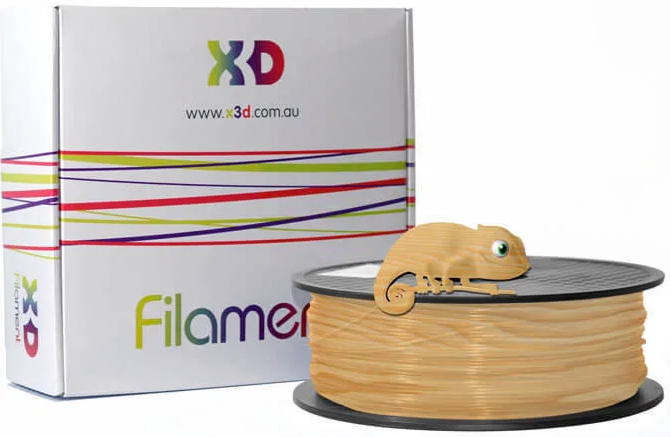There are plenty of wood filaments on the market that give off a realistic wooden look and feel on 3D prints that you would be surprised that they are not totally made of wood. Wood filaments are typically composite materials that are made up of a PLA base and some type of wood derivatives, such as cork or wood dust. However, there are some filaments that have no wood particles at all, but these usually produce a different texture in 3D prints.
Unlike other composite filaments such as metal-infused and carbon fiber filaments, wood filaments are gentler on nozzles as wood is a lot softer. Nonetheless, they still cause partial clogging to small nozzles over time.
Wood filaments are best used when creating decorations, toys, and cosplay props.
Features
- Produces a wooden surface: Due to the wood particles in the filament, it can produce 3D prints that have realistic wooden surface.
- Pleasant smell during printing: It has a sugary smell during printing since the filament has a PLA base.
- Not as abrasive on nozzles: Wood is softer than metals or carbon fiber, therefore it is not as damaging to nozzles as other composite materials.
Tradeoffs
- Requires a larger nozzle: The wood particles can be hard on smaller nozzles and cause partial clogging over time. Make sure to only use larger nozzles when printing with wood filaments
- Increases risk of stringing: Stringing happens due to the wood particles, which prevent the nozzle from maintaining the required suction while moving.
Wood Filament Print Settings
- Bed settings: Not usually required, but some users prefer setting the temperature to 50° C
- Extruder temperature: 190 – 240° C
Tips to 3D Printing with Wood Filaments
- Adjust retraction settings: Since wood filaments are prone to stringing, prevent it from happening by adjusting the retraction settings. Use a negative value in the setting by starting with either -0.1mm or -0.2mm.
- Use larger nozzles: To prevent the wood filament from wreaking havoc on your nozzle, use 0.5mm nozzles and up. Remember to clear it from time to time as it still causes partial clogging over time.
- Increase the layer height: Wood filament is much more forgiving on 3D prints as layer lines aren’t as visible on them. You can get away with a larger layer height, therefore improving printing efficiency.
- Play with the temperature (a bit): The colour of the 3D prints produced by wood filaments vary depending on the printing temperature.
- Use sandpaper when processing: Due to its wood component, 3D prints produced by this filament can easily be post-processed by using sandpaper.
Best Wood Filaments on the Market
X3D Pro Wood Filament

The X3D Pro Wood Filament uses recycled wood, which makes it environmentally friendly. It produces 3D prints that can be cut, sanded, and painted just like wooden sculptures.
Formfutura EasyWood
The Formfutura EasyWood looks and feels like real wood with its higher-than-usual 40% grinded wood composition. It is also easy to print with.
ColorFabb WoodFill
The ColorFabb WoodFill is also made partly of recycled wood fibres. It produces durable 3D prints despite the PLA base.
Polymaker PolyWood
Polymaker PolyWood does not contain any wood particles at all. It employs a unique foaming technology that replicates the look and feel of wood. It also minimises visual layering which produces an excellent surface finish.
Printing with wood filaments is so easy that even 3D printing newbies can do it. If you have any questions about wood filaments or 3D printing in general, you can contact us through email at x3d@x3d.com.au.

